The ledge of rock in pounded ore is in great work to the look of the sand for the footprint of proven by the books of text to require word faith to be the judgement hand that wrote the worth in the value of the book. The or a version is in contents to the rock as the grain is the sand of the precision. To witness word at seated is in effect the curse and thereby Cantore Arithmetic is able to define cursed and work word to the b balance of a beach in sand at rock of land.
Although the sand in grain is oats, the feed is the reality of the ledge as to understand the work the word would be a message in the furrow for the cloud as to move the hoe for the flood of cursed in value of weather as the color of snow brings rain to the direction of the language as the accent: Greater than, Lesser than: Dividing Line!!
A silver screen tripod with explanation to slides brings word to text: Test. This value is still measure at tripod and the access to stand is a plateau: The table.
Cantore Arithmetic is able to state shades equated modern day action of and by racism to the prejudice of and at the process of color, shape, and possible stile: Gates. The doors are at current housing with regard of the nations Roe v. Wade: 410 U.S. 113 (1973),[1] was a landmark decision of the U.S. Supreme Court in which the Court ruled that the Constitution of the United States generally protected a right to have an abortion.
Fence: Horse a round as the arena to now is the movies as the theater piece! To gain material at that stopwatch would regain the fibromyalgia as comprehended: Comb the Hare! This is a difficult task as rabbits’ are in hopscotch. To remove as a piece in moved the hare is capable of being counted as H are in the saddled girth of h air: Too atmosphere. This is a double hyphen barreled gun!! However comma the saying to coffee at the table is no longer an elephant in the room as The Green Apple now has that ability. Resolving the saying to the Elephant and a new Board Game for development is titled for The Green Apple for learning the advancement of Yield: What’s Your Problem. As stucco equated wood!
You searched for
"WOOD" in the KJV Bible
132 Instances - Page 1 of 5 - Sort by Book Order - Feedback
- 1 Kings 18:33chapter context similar meaning copy save
- And he put the wood in order, and cut the bullock in pieces, and laid him on the wood, and said, Fill four barrels with water, and pour it on the burnt sacrifice, and on the wood.
- Genesis 22:9chapter context similar meaning copy save
- And they came to the place which God had told him of; and Abraham built an altar there, and laid the wood in order, and bound Isaac his son, and laid him on the altar upon the wood.
- Revelation 18:12chapter context similar meaning copy save
- The merchandise of gold, and silver, and precious stones, and of pearls, and fine linen, and purple, and silk, and scarlet, and all thyine wood, and all manner vessels of ivory, and all manner vessels of most precious wood, and of brass, and iron, and marble,
- Deuteronomy 19:5chapter context similar meaning copy save
- As when a man goeth into the wood with his neighbour to hew wood, and his hand fetcheth a stroke with the axe to cut down the tree, and the head slippeth from the helve, and lighteth upon his neighbour, that he die; he shall flee unto one of those cities, and live:
- Ezekiel 41:22chapter context similar meaning copy save
- The altar of wood was three cubits high, and the length thereof two cubits; and the corners thereof, and the length thereof, and the walls thereof, were of wood: and he said unto me, This is the table that is before the LORD.
- 1 Kings 18:23chapter context similar meaning copy save
- Let them therefore give us two bullocks; and let them choose one bullock for themselves, and cut it in pieces, and lay it on wood, and put no fire under: and I will dress the other bullock, and lay it on wood, and put no fire under:
- Job 41:27chapter context similar meaning copy save
- He esteemeth iron as straw, and brass as rotten wood.
- Song of Solomon 3:9chapter context similar meaning copy save
- King Solomon made himself a chariot of the wood of Lebanon.
- Exodus 36:20chapter context similar meaning copy save
- And he made boards for the tabernacle of shittim wood, standing up.
- Exodus 26:15chapter context similar meaning copy save
- And thou shalt make boards for the tabernacle of shittim wood standing up.
- 1 Chronicles 29:2chapter context similar meaning copy save
- Now I have prepared with all my might for the house of my God the gold for things to be made of gold, and the silver for things of silver, and the brass for things of brass, the iron for things of iron, and wood for things of wood; onyx stones, and stones to be set, glistering stones, and of divers colours, and all manner of precious stones, and marble stones in abundance.
- 1 Corinthians 3:12chapter context similar meaning copy save
- Now if any man build upon this foundation gold, silver, precious stones, wood, hay, stubble;
- Exodus 37:4chapter context similar meaning copy save
- And he made staves of shittim wood, and overlaid them with gold.
- Lamentations 5:4chapter context similar meaning copy save
- We have drunken our water for money; our wood is sold unto us.
- Exodus 38:6chapter context similar meaning copy save
- And he made the staves of shittim wood, and overlaid them with brass.
- Ecclesiastes 2:6chapter context similar meaning copy save
- I made me pools of water, to water therewith the wood that bringeth forth trees:
- Proverbs 26:21chapter context similar meaning copy save
- As coals are to burning coals, and wood to fire; so is a contentious man to kindle strife.
- Exodus 37:28chapter context similar meaning copy save
- And he made the staves of shittim wood, and overlaid them with gold.
- Psalms 132:6chapter context similar meaning copy save
- Lo, we heard of it at Ephratah: we found it in the fields of the wood.
- 2 Kings 6:4chapter context similar meaning copy save
- So he went with them. And when they came to Jordan, they cut down wood.
- Exodus 25:13chapter context similar meaning copy save
- And thou shalt make staves of shittim wood, and overlay them with gold.
- Ecclesiastes 10:9chapter context similar meaning copy save
- Whoso removeth stones shall be hurt therewith; and he that cleaveth wood shall be endangered thereby.
- Exodus 30:5chapter context similar meaning copy save
- And thou shalt make the staves of shittim wood, and overlay them with gold.
- Ezekiel 15:3chapter context similar meaning copy save
- Shall wood be taken thereof to do any work? or will men take a pin of it to hang any vessel thereon?
- Exodus 35:33chapter context similar meaning copy save
- And in the cutting of stones, to set them, and in carving of wood, to make any manner of cunning work.
- 1 Chronicles 22:4chapter context similar meaning copy save
- Also cedar trees in abundance: for the Zidonians and they of Tyre brought much cedar wood to David.
- Psalms 141:7chapter context similar meaning copy save
- Our bones are scattered at the grave's mouth, as when one cutteth and cleaveth wood upon the earth.
- Lamentations 5:13chapter context similar meaning copy save
- They took the young men to grind, and the children fell under the wood.
- Exodus 36:31chapter context similar meaning copy save
- And he made bars of shittim wood; five for the boards of the one side of the tabernacle,
- Daniel 5:4chapter context similar meaning copy save
- They drank wine, and praised the gods of gold, and of silver, of brass, of iron, of wood, and of stone.
This is page: 1 of 5
1 2 3 4 5 Next >
You searched for
"WOOD" in the KJV Bible
34 Instances - Page 1 of 2 - Sort by Book Order - Feedback
- Wisdom of Solomon 14:7chapter context similar meaning copy save
- For blessed is the wood whereby righteousness cometh.
- Letter of Jeremiah 1:57chapter context similar meaning copy save
- Neither are those gods of wood, and laid over with silver or gold, able to escape either from thieves or robbers.
- Ecclesiasticus 8:3chapter context similar meaning copy save
- Strive not with a man that is full of tongue, and heap not wood upon his fire.
- Ecclesiasticus 38:5chapter context similar meaning copy save
- Was not the water made sweet with wood, that the virtue thereof might be known?
- Letter of Jeremiah 1:30chapter context similar meaning copy save
- For how can they be called gods? because women set meat before the gods of silver, gold, and wood.
- Letter of Jeremiah 1:70chapter context similar meaning copy save
- For as a scarecrow in a garden of cucumbers keepeth nothing: so are their gods of wood, and laid over with silver and gold.
- 2 Esdras 4:16chapter context similar meaning copy save
- The thought of the wood was in vain, for the fire came and consumed it.
- Letter of Jeremiah 1:4chapter context similar meaning copy save
- Now shall ye see in Babylon gods of silver, and of gold, and of wood, borne upon shoulders, which cause the nations to fear.
- 1 Esdras 9:42chapter context similar meaning copy save
- And Esdras the priest and reader of the law stood up upon a pulpit of wood, which was made for that purpose.
- Letter of Jeremiah 1:50chapter context similar meaning copy save
- For seeing they be but of wood, and overlaid with silver and gold, it shall be known hereafter that they are false:
- Prayer of Azariah 1:23chapter context similar meaning copy save
- And the king's servants, that put them in, ceased not to make the oven hot with rosin, pitch, tow, and small wood;
- Wisdom of Solomon 14:1chapter context similar meaning copy save
- Again, one preparing himself to sail, and about to pass through the raging waves, calleth upon a piece of wood more rotten than the vessel that carrieth him.
- Wisdom of Solomon 10:4chapter context similar meaning copy save
- For whose cause the earth being drowned with the flood, wisdom again preserved it, and directed the course of the righteous in a piece of wood of small value.
- 2 Esdras 5:23chapter context similar meaning copy save
- And said, O Lord that bearest rule, of every wood of the earth, and of all the trees thereof, thou hast chosen thee one only vine:
- Letter of Jeremiah 1:11chapter context similar meaning copy save
- Yea, they will give thereof to the common harlots, and deck them as men with garments, being gods of silver, and gods of gold, and wood.
- Letter of Jeremiah 1:55chapter context similar meaning copy save
- Whereupon when fire falleth upon the house of gods of wood, or laid over with gold or silver, their priests will flee away, and escape; but they themselves shall be burned asunder like beams.
- 2 Esdras 16:6chapter context similar meaning copy save
- May any man drive away an hungry lion in the wood? or may any one quench the fire in stubble, when it hath begun to burn?
- Wisdom of Solomon 14:5chapter context similar meaning copy save
- Nevertheless thou wouldest not that the works of thy wisdom should be idle, and therefore do men commit their lives to a small piece of wood, and passing the rough sea in a weak vessel are saved.
- 2 Esdras 15:42chapter context similar meaning copy save
- And they shall break down the cities and walls, mountains and hills, trees of the wood, and grass of the meadows, and their corn.
- 2 Esdras 11:37chapter context similar meaning copy save
- And I beheld, and lo, as it were a roaring lion chased out of the wood: and I saw that he sent out a man's voice unto the eagle, and said,
- Letter of Jeremiah 1:71chapter context similar meaning copy save
- And likewise their gods of wood, and laid over with silver and gold, are like to a white thorn in an orchard, that every bird sitteth upon; as also to a dead body, that is east into the dark.
- 2 Esdras 5:5chapter context similar meaning copy save
- And blood shall drop out of wood, and the stone shall give his voice, and the people shall be troubled:
- 2 Esdras 4:19chapter context similar meaning copy save
- I answered and said, Verily it is a foolish thought that they both have devised, for the ground is given unto the wood, and the sea also hath his place to bear his floods.
- Letter of Jeremiah 1:39chapter context similar meaning copy save
- Their gods of wood, and which are overlaid with gold and silver, are like the stones that be hewn out of the mountain: they that worship them shall be confounded.
- Wisdom of Solomon 13:13chapter context similar meaning copysave
- And taking the very refuse among those which served to no use, being a crooked piece of wood, and full of knots, hath carved it diligently, when he had nothing else to do, and formed it by the skill of his understanding, and fashioned it to the image of a man;
- 1 Maccabees 9:45chapter context similar meaning copy save
- For, behold, the battle is before us and behind us, and the water of Jordan on this side and that side, the marsh likewise and wood, neither is there place for us to turn aside.
- 1 Esdras 6:25chapter context similar meaning copy save
- Whose height shall be sixty cubits and the breadth sixty cubits, with three rows of hewn stones, and one row of new wood of that country; and the expences thereof to be given out of the house of king Cyrus:
- 2 Maccabees 1:21chapter context similar meaning copy save
- Then commanded he them to draw it up, and to bring it; and when the sacrifices were laid on, Neemias commanded the priests to sprinkle the wood and the things laid thereupon with the water.
- 2 Esdras 12:31chapter context similar meaning copy save
- And the lion, whom thou sawest rising up out of the wood, and roaring, and speaking to the eagle, and rebuking her for her unrighteousness with all the words which thou hast heard;
- 2 Esdras 15:30chapter context similar meaning copy save
- Also the Carmanians raging in wrath shall go forth as the wild boars of the wood, and with great power shall they come, and join battle with them, and shall waste a portion of the land of the Assyrians.
This is page: 1 of 2
1 2 Next >
You searched for
"HARE" in the KJV Bible
2 Instances - Page 1 of 1 - Sort by Book Order - Feedback
- Leviticus 11:6chapter context similar meaning copy save
- And the hare, because he cheweth the cud, but divideth not the hoof; he is unclean unto you.
- Deuteronomy 14:7chapter context similar meaning copy save
- Nevertheless these ye shall not eat of them that chew the cud, or of them that divide the cloven hoof; as the camel, and the hare, and the coney: for they chew the cud, but divide not the hoof; therefore they are unclean unto you.
You searched for
"FENCE" in the KJV Bible
1 Instances - Page 1 of 1 - Sort by Book Order - Feedback
- Psalms 62:3chapter context similar meaning copy save
- How long will ye imagine mischief against a man? ye shall be slain all of you: as a bowing wall shall ye be, and as a tottering fence.
You searched for
"PERHAPS" in the KJV Bible
3 Instances - Page 1 of 1 - Sort by Book Order - Feedback
- Acts 8:22chapter context similar meaning copy save
- Repent therefore of this thy wickedness, and pray God, if perhaps the thought of thine heart may be forgiven thee.
- Philemon 1:15chapter context similar meaning copy save
- For perhaps he therefore departed for a season, that thou shouldest receive him for ever;
- 2 Corinthians 2:7chapter context similar meaning copy save
- So that contrariwise ye ought rather to forgive him, and comfort him, lest perhapssuch a one should be swallowed up with overmuch sorrow.
You searched for
"SILVER" in the KJV Bible
282 Instances - Page 1 of 10 - Sort by Book Order - Feedback
- Exodus 38:17chapter context similar meaning copy save
- And the sockets for the pillars were of brass; the hooks of the pillars and their fillets of silver; and the overlaying of their chapiters of silver; and all the pillars of the court were filleted with silver.
- Exodus 27:17chapter context similar meaning copy save
- All the pillars round about the court shall be filleted with silver; their hooks shall be of silver, and their sockets of brass.
- Ecclesiastes 5:10chapter context similar meaning copy save
- He that loveth silver shall not be satisfied with silver; nor he that loveth abundance with increase: this is also vanity.
- Malachi 3:3chapter context similar meaning copy save
- And he shall sit as a refiner and purifier of silver: and he shall purify the sons of Levi, and purge them as gold and silver, that they may offer unto the LORD an offering in righteousness.
- Numbers 7:43chapter context similar meaning copy save
- His offering was one silver charger of the weight of an hundred and thirty shekels, a silver bowl of seventy shekels, after the shekel of the sanctuary; both of them full of fine flour mingled with oil for a meat offering:
- Numbers 7:84chapter context similar meaning copy save
- This was the dedication of the altar, in the day when it was anointed, by the princes of Israel: twelve chargers of silver, twelve silver bowls, twelve spoons of gold:
- 2 Kings 6:25chapter context similar meaning copy save
- And there was a great famine in Samaria: and, behold, they besieged it, until an ass's head was sold for fourscore pieces of silver, and the fourth part of a cab of dove's dung for five pieces of silver.
- Genesis 23:16chapter context similar meaning copy save
- And Abraham hearkened unto Ephron; and Abraham weighed to Ephron the silver, which he had named in the audience of the sons of Heth, four hundred shekels of silver, current money with the merchant.
- Numbers 7:55chapter context similar meaning copy save
- His offering was one silver charger of the weight of an hundred and thirty shekels, one silver bowl of seventy shekels, after the shekel of the sanctuary; both of them full of fine flour mingled with oil for a meat offering:
- Numbers 7:31chapter context similar meaning copy save
- His offering was one silver charger of the weight of an hundred and thirty shekels, one silver bowl of seventy shekels, after the shekel of the sanctuary; both of them full of fine flour mingled with oil for a meat offering:
- Ezra 8:26chapter context similar meaning copy save
- I even weighed unto their hand six hundred and fifty talents of silver, and silvervessels an hundred talents, and of gold an hundred talents;
- 2 Kings 12:13chapter context similar meaning copy save
- Howbeit there were not made for the house of the LORD bowls of silver, snuffers, basons, trumpets, any vessels of gold, or vessels of silver, of the money that was brought into the house of the LORD:
- 1 Chronicles 28:16chapter context similar meaning copy save
- And by weight he gave gold for the tables of shewbread, for every table; and likewise silver for the tables of silver:
- Numbers 7:85chapter context similar meaning copy save
- Each charger of silver weighing an hundred and thirty shekels, each bowl seventy: all the silver vessels weighed two thousand and four hundred shekels, after the shekel of the sanctuary:
- 2 Kings 25:15chapter context similar meaning copy save
- And the firepans, and the bowls, and such things as were of gold, in gold, and of silver, in silver, the captain of the guard took away.
- Exodus 38:19chapter context similar meaning copy save
- And their pillars were four, and their sockets of brass four; their hooks of silver, and the overlaying of their chapiters and their fillets of silver.
- Numbers 7:49chapter context similar meaning copy save
- His offering was one silver charger, the weight whereof was an hundred and thirty shekels, one silver bowl of seventy shekels, after the shekel of the sanctuary; both of them full of fine flour mingled with oil for a meat offering:
- Numbers 7:61chapter context similar meaning copy save
- His offering was one silver charger, the weight whereof was an hundred and thirty shekels, one silver bowl of seventy shekels, after the shekel of the sanctuary; both of them full of fine flour mingled with oil for a meat offering:
- Numbers 7:37chapter context similar meaning copy save
- His offering was one silver charger, the weight whereof was an hundred and thirty shekels, one silver bowl of seventy shekels, after the shekel of the sanctuary; both of them full of fine flour mingled with oil for a meat offering:
- Numbers 7:79chapter context similar meaning copy save
- His offering was one silver charger, the weight whereof was an hundred and thirty shekels, one silver bowl of seventy shekels, after the shekel of the sanctuary; both of them full of fine flour mingled with oil for a meat offering:
- Numbers 7:73chapter context similar meaning copy save
- His offering was one silver charger, the weight whereof was an hundred and thirty shekels, one silver bowl of seventy shekels, after the shekel of the sanctuary; both of them full of fine flour mingled with oil for a meat offering:
- Numbers 7:67chapter context similar meaning copy save
- His offering was one silver charger, the weight whereof was an hundred and thirty shekels, one silver bowl of seventy shekels, after the shekel of the sanctuary; both of them full of fine flour mingled with oil for a meat offering:
- Numbers 7:25chapter context similar meaning copy save
- His offering was one silver charger, the weight whereof was an hundred and thirty shekels, one silver bowl of seventy shekels, after the shekel of the sanctuary; both of them full of fine flour mingled with oil for a meat offering:
- Numbers 7:19chapter context similar meaning copy save
- He offered for his offering one silver charger, the weight whereof was an hundred and thirty shekels, one silver bowl of seventy shekels, after the shekel of the sanctuary; both of them full of fine flour mingled with oil for a meat offering:
- Esther 1:6chapter context similar meaning copy save
- Where were white, green, and blue, hangings, fastened with cords of fine linen and purple to silver rings and pillars of marble: the beds were of gold and silver, upon a pavement of red, and blue, and white, and black, marble.
- Joshua 7:21chapter context similar meaning copy save
- When I saw among the spoils a goodly Babylonish garment, and two hundred shekels of silver, and a wedge of gold of fifty shekels weight, then I coveted them, and took them; and, behold, they are hid in the earth in the midst of my tent, and the silver under it.
- Numbers 7:13chapter context similar meaning copy save
- And his offering was one silver charger, the weight thereof was an hundred and thirty shekels, one silver bowl of seventy shekels, after the shekel of the sanctuary; both of them were full of fine flour mingled with oil for a meat offering:
- 1 Chronicles 29:5chapter context similar meaning copy save
- The gold for things of gold, and the silver for things of silver, and for all manner of work to be made by the hands of artificers. And who then is willing to consecrate his service this day unto the LORD?
- Judges 17:2chapter context similar meaning copy save
- And he said unto his mother, The eleven hundred shekels of silver that were taken from thee, about which thou cursedst, and spakest of also in mine ears, behold, the silver is with me; I took it. And his mother said, Blessed be thou of the LORD, my son.
- Judges 17:3chapter context similar meaning copy save
- And when he had restored the eleven hundred shekels of silver to his mother, his mother said, I had wholly dedicated the silver unto the LORD from my hand for my son, to make a graven image and a molten image: now therefore I will restore it unto thee.
This is page: 1 of 10
1 2 3 4 5 6 7 8 9 10 Next >
Beach
This article includes a list of general references, but it lacks sufficient corresponding inline citations. (November 2020) |

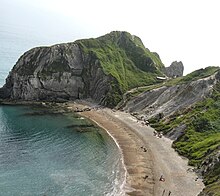
A beach is a landform alongside a body of water which consists of loose particles. The particles composing a beach are typically made from rock, such as sand, gravel, shingle, pebbles, etc., or biological sources, such as mollusc shells or coralline algae. Sediments settle in different densities and structures, depending on the local wave action and weather, creating different textures, colors and gradients or layers of material.
Though some beaches form on inland freshwater locations such as lakes and rivers, most beaches are in coastal areas where wave or current action deposits and reworks sediments. Erosion and changing of beach geologies happens through natural processes, like wave action and extreme weather events. Where wind conditions are correct, beaches can be backed by coastal dunes which offer protection and regeneration for the beach. However, these natural forces have become more extreme due to climate change, permanently altering beaches at very rapid rates. Some estimates describe as much as 50 percent of the earth's sandy beaches disappearing by 2100 due to climate-change driven sea level rise.[1]
Sandy beaches occupy about one third of global coastlines.[1] These beaches are popular for recreation, playing important economic and cultural roles—often driving local tourism industries. To support these uses, some beaches have human-made infrastructure, such as lifeguard posts, changing rooms, showers, shacks and bars. They may also have hospitality venues (such as resorts, camps, hotels, and restaurants) nearby or housing, both for permanent and seasonal residents.
Human forces have significantly changed beaches globally: direct impacts include bad construction practices on dunes and coastlines, while indirect human impacts include water pollution, plastic pollution and coastal erosionfrom sea level rise and climate change. Some coastal management practices are designed to preserve or restore natural beach processes, while some beaches are actively restored through practices like beach nourishment.
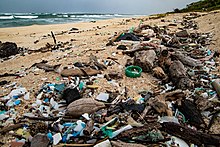
Wild beaches, also known as undeveloped or undiscovered beaches, are not developed for tourism or recreation. Preserved beaches are important biomes with important roles in aquatic or marine biodiversity, such as for breeding grounds for sea turtles or nesting areas for seabirds or penguins. Preserved beaches and their associated dune are important for protection from extreme weather for inland ecosystems and human infrastructure.[1]
Location and profile
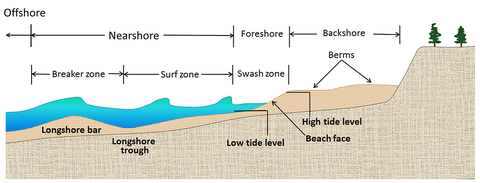
Although the seashore is most commonly associated with the word beach, beaches are also found by lakes and alongside large rivers.
Beach may refer to:
- small systems where rock material moves onshore, offshore, or alongshore by the forces of waves and currents; or
- geological units of considerable size.
The former are described in detail below; the larger geological units are discussed elsewhere under bars.
There are several conspicuous parts to a beach that relate to the processes that form and shape it. The part mostly above water (depending upon tide), and more or less actively influenced by the waves at some point in the tide, is termed the beach berm. The bermis the deposit of material comprising the active shoreline. The berm has a crest (top) and a face—the latter being the slope leading down towards the water from the crest. At the very bottom of the face, there may be a trough, and further seaward one or more long shore bars: slightly raised, underwater embankments formed where the waves first start to break.
The sand deposit may extend well inland from the berm crest, where there may be evidence of one or more older crests (the storm beach) resulting from very large storm waves and beyond the influence of the normal waves. At some point the influence of the waves (even storm waves) on the material comprising the beach stops, and if the particles are small enough (sand size or smaller), winds shape the feature. Where wind is the force distributing the grains inland, the deposit behind the beach becomes a dune.

These geomorphic features compose what is called the beach profile. The beach profile changes seasonally due to the change in wave energy experienced during summer and winter months. In temperate areas where summer is characterised by calmer seas and longer periods between breaking wave crests, the beach profile is higher in summer. The gentle wave action during this season tends to transport sediment up the beach towards the berm where it is deposited and remains while the water recedes. Onshore winds carry it further inland forming and enhancing dunes.
Conversely, the beach profile is lower in the storm season (winter in temperate areas) due to the increased wave energy, and the shorter periods between breaking wave crests. Higher energy waves breaking in quick succession tend to mobilise sediment from the shallows, keeping it in suspension where it is prone to be carried along the beach by longshore currents, or carried out to sea to form longshore bars, especially if the longshore current meets an outflow from a river or flooding stream. The removal of sediment from the beach berm and dune thus decreases the beach profile.
If storms coincide with unusually high tides, or with a freak wave event such as a tidal surge or tsunami which causes significant coastal flooding, substantial quantities of material may be eroded from the coastal plain or dunes behind the berm by receding water. This flow may alter the shape of the coastline, enlarge the mouths of rivers and create new deltas at the mouths of streams that had not been powerful enough to overcome longshore movement of sediment.
The line between beach and dune is difficult to define in the field. Over any significant period of time, sediment is always being exchanged between them. The drift line (the high point of material deposited by waves) is one potential demarcation. This would be the point at which significant wind movement of sand could occur, since the normal waves do not wet the sand beyond this area. However, the drift line is likely to move inland under assault by storm waves.[3]
Formation



Beaches are the result of wave action by which waves or currents move sand or other loose sediments of which the beach is made as these particles are held in suspension. Alternatively, sand may be moved by saltation (a bouncing movement of large particles). Beach materials come from erosion of rocks offshore, as well as from headland erosion and slumping producing deposits of scree. A coral reef offshore is a significant source of sand particles. Some species of fish that feed on algae attached to coral outcrops and rocks can create substantial quantities of sand particles over their lifetime as they nibble during feeding, digesting the organic matter, and discarding the rock and coral particles which pass through their digestive tracts.
The composition of the beach depends upon the nature and quantity of sediments upstream of the beach, and the speed of flow and turbidity of water and wind. Sediments are moved by moving water and wind according to their particle size and state of compaction. Particles tend to settle and compact in still water. Once compacted, they are more resistant to erosion. Established vegetation (especially species with complex network root systems) will resist erosion by slowing the fluid flow at the surface layer. When affected by moving water or wind, particles that are eroded and held in suspension will increase the erosive power of the fluid that holds them by increasing the average density, viscosity, and volume of the moving fluid.
Coastlines facing very energetic wind and wave systems will tend to hold only large rocks as smaller particles will be held in suspension in the turbid water column and carried to calmer areas by longshore currents and tides. Coastlines that are protected from waves and winds will tend to allow finer sediments such as clay and mud to precipitate creating mud flats and mangrove forests. The shape of a beach depends on whether the waves are constructive or destructive, and whether the material is sand or shingle. Waves are constructive if the period between their wave crests is long enough for the breaking water to recede and the sediment to settle before the succeeding wave arrives and breaks.
Fine sediment transported from lower down the beach profile will compact if the receding water percolates or soaks into the beach. Compacted sediment is more resistant to movement by turbulent water from succeeding waves. Conversely, waves are destructive if the period between the wave crests is short. Sediment that remains in suspension when the following wave crest arrives will not be able to settle and compact and will be more susceptible to erosion by longshore currents and receding tides. The nature of sediments found on a beach tends to indicate the energy of the waves and wind in the locality.
Constructive waves move material up the beach while destructive waves move the material down the beach. During seasons when destructive waves are prevalent, the shallows will carry an increased load of sediment and organic matter in suspension. On sandy beaches, the turbulent backwash of destructive waves removes material forming a gently sloping beach. On pebble and shingle beaches the swash is dissipated more quickly because the large particle size allows greater percolation, thereby reducing the power of the backwash, and the beach remains steep. Compacted fine sediments will form a smooth beach surface that resists wind and water erosion.
During hot calm seasons, a crust may form on the surface of ocean beaches as the heat of the sun evaporates the water leaving the salt which crystallises around the sand particles. This crust forms an additional protective layer that resists wind erosion unless disturbed by animals or dissolved by the advancing tide. Cusps and horns form where incoming waves divide, depositing sand as horns and scouring out sand to form cusps. This forms the uneven face on some sand shorelines. White sand beaches look white because the quartz or eroded limestone in the sand reflects or scatters sunlight without absorbing other colors.
Sand colors
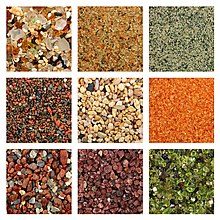
glass, dune, quartz
volcanic, biogenic coral, pink coral
volcanic, garnet, olivine
The composition of the sand varies depending on the local minerals and geology.[4] Some of the types of sand found in beaches around the world are:
- White sand: Mostly made of quartz and limestone, it can also contain other minerals like feldspar and gypsum .[4][5]
- Light-colored sand: This sand gets its color from quartz and iron,[4] and is the most common sand color in Southern Europe[6] and other regions of the Mediterranean Basin, such as Tunisia.[4]
- Tropical white sand: On tropical islands, the sand is composed of calcium carbonate from the shells and skeletons of marine organisms, like corals and mollusks, as found in Aruba.[4]
- Pink coral sand: Like the above, is composed of calcium carbonate and gets its pink hue from fragments of coral, such as in Bermuda and the Bahama Islands.[4]
- Black sand: Black sand is composed of volcanic rock, like basalt and obsidian, which give it its gray-black color.[4] Hawaii's Punaluu Beach, Madeira's Praia Formosa and Fuerteventura's Ajuy beach are examples of this type of sand.[4]
- Red sand: This kind of sand is created by the oxidation of iron from volcanic rocks.[5] Santorini's Kokkini Beach or the beaches on Prince Edward Island in Canada are examples of this kind of sand.[5]
- Orange sand: Orange sand is high on iron. It can also me a combination of orange limestone, crushed shells, and volcanic deposits.[5] Ramla Bay in Gozo, Malta or Porto Ferro in Sardinia are examples of each, respectively.[4]
- Green sand: In this kind of sand, the mineral olivine has been separated from other volcanic fragments by erosive forces.[4] A famous example is Hawaii's Papakolea Beach, which has sand containing basalt and coral fragments.[4] Olivine beaches have high potential for carbon sequestration, and artificial greensand beaches are being explored for this process by Project Vesta.[7]
Erosion and accretion
Natural erosion and accretion


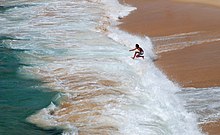
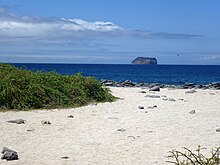


Causes
Beaches are changed in shape chiefly by the movement of water and wind. Any weather event that is associated with turbid or fast-flowing water or high winds will erode exposed beaches. Longshore currents will tend to replenish beach sediments and repair storm damage. Tidal waterways generally change the shape of their adjacent beaches by small degrees with every tidal cycle. Over time these changes can become substantial leading to significant changes in the size and location of the beach.
Effects on flora
Changes in the shape of the beach may undermine the roots of large trees and other flora. Many beach adapted species (such as coconut palms) have a fine root system and large root ball which tends to withstand wave and wind action and tends to stabilize beaches better than other trees with a lesser root ball.
Effects on adjacent land
Erosion of beaches can expose less resilient soils and rocks to wind and wave action leading to undermining of coastal headlands eventually resulting in catastrophic collapse of large quantities of overburden into the shallows. This material may be distributed along the beach front leading to a change in the habitat as sea grasses and corals in the shallows may be buried or deprived of light and nutrients.
Humanmade erosion and accretion
Coastal areas settled by man inevitably become subject to the effects of human-made structures and processes. Over long periods of time, these influences may substantially alter the shape of the coastline, and the character of the beach.
Destruction of flora
Beachfront flora plays a major role in stabilizing the foredunes and preventing beach head erosion and inland movement of dunes. If flora with network root systems (creepers, grasses, and palms) are able to become established, they provide an effective coastal defense as they trap sand particles and rainwater and enrich the surface layer of the dunes, allowing other plant species to become established. They also protect the berm from erosion by high winds, freak waves and subsiding floodwaters.
Over long periods of time, well-stabilized foreshore areas will tend to accrete, while unstabilized foreshores will tend to erode, leading to substantial changes in the shape of the coastline. These changes usually occur over periods of many years. Freak wave events such as tsunami, tidal waves, and storm surges may substantially alter the shape, profile and location of a beach within hours.
Destruction of flora on the berm by the use of herbicides, excessive pedestrian or vehicle traffic, or disruption to freshwater flows may lead to erosion of the berm and dunes. While the destruction of flora may be a gradual process that is imperceptible to regular beach users, it often becomes immediately apparent after storms associated with high winds and freak wave events that can rapidly move large volumes of exposed and unstable sand, depositing them further inland, or carrying them out into the permanent water forming offshore bars, lagoons or increasing the area of the beach exposed at low tide. Large and rapid movements of exposed sand can bury and smother flora in adjacent areas, aggravating the loss of habitat for fauna, and enlarging the area of instability. If there is an adequate supply of sand, and weather conditions do not allow vegetation to recover and stabilize the sediment, wind-blown sand can continue to advance, engulfing and permanently altering downwind landscapes.
Sediment moved by waves or receding floodwaters can be deposited in coastal shallows, engulfing reed beds and changing the character of underwater flora and fauna in the coastal shallows.
Burning or clearance of vegetation on the land adjacent to the beach head, for farming and residential development, changes the surface wind patterns, and exposes the surface of the beach to wind erosion.
Farming and residential development are also commonly associated with changes in local surface water flows. If these flows are concentrated in stormwater drains emptying onto the beach head, they may erode the beach creating a lagoon or delta.
Dense vegetation tends to absorb rainfall reducing the speed of runoff and releasing it over longer periods of time. Destruction by burning or clearance of the natural vegetation tends to increase the speed and erosive power of runoff from rainfall. This runoff will tend to carry more silt and organic matter from the land onto the beach and into the sea. If the flow is constant, runoff from cleared land arriving at the beach head will tend to deposit this material into the sand changing its color, odor and fauna.
Creation of beach access points
The concentration of pedestrian and vehicular traffic accessing the beach for recreational purposes may cause increased erosion at the access points if measures are not taken to stabilize the beach surface above high-water mark. Recognition of the dangers of loss of beach front flora has caused many local authorities responsible for managing coastal areas to restrict beach access points by physical structures or legal sanctions, and fence off foredunes in an effort to protect the flora. These measures are often associated with the construction of structures at these access points to allow traffic to pass over or through the dunes without causing further damage.
Concentration of runoff
Beaches provide a filter for runoff from the coastal plain. If the runoff is naturally dispersed along the beach, water borne silt and organic matter will be retained on the land and will feed the flora in the coastal area. Runoff that is dispersed along the beach will tend to percolate through the beach and may emerge from the beach at low tide.
The retention of the freshwater may also help to maintain underground water reserves and will resist salt water incursion. If the surface flow of the runoff is diverted and concentrated by drains that create constant flows over the beach above the sea or river level, the beach will be eroded and ultimately form an inlet unless longshore flows deposit sediments to repair the breach.
Once eroded, an inlet may allow tidal inflows of salt water to pollute areas inland from the beach and may also affect the quality of underground water supplies and the height of the water table.
Deprivation of runoff
Some flora naturally occurring on the beach head requires freshwater runoff from the land. Diversion of freshwater runoff into drains may deprive these plants of their water supplies and allow sea water incursion, increasing the saltiness of the groundwater. Species that are not able to survive in salt water may die and be replaced by mangroves or other species adapted to salty environments.
Inappropriate beach nourishment
Beach nourishment is the importing and deposition of sand or other sediments in an effort to restore a beach that has been damaged by erosion. Beach nourishment often involves excavation of sediments from riverbeds or sand quarries. This excavated sediment may be substantially different in size and appearance to the naturally occurring beach sand.
In extreme cases, beach nourishment may involve placement of large pebbles or rocks in an effort to permanently restore a shoreline subject to constant erosion and loss of foreshore. This is often required where the flow of new sediment caused by the longshore current has been disrupted by construction of harbors, breakwaters, causeways or boat ramps, creating new current flows that scour the sand from behind these structures and deprive the beach of restorative sediments. If the causes of the erosion are not addressed, beach nourishment can become a necessary and permanent feature of beach maintenance.
During beach nourishment activities, care must be taken to place new sediments so that the new sediments compact and stabilize before aggressive wave or wind action can erode them. Material that is concentrated too far down the beach may form a temporary groyne that will encourage scouring behind it. Sediments that are too fine or too light may be eroded before they have compacted or been integrated into the established vegetation. Foreign unwashed sediments may introduce flora or fauna that are not usually found in that locality.
Brighton Beach, on the south coast of England, is a shingle beach that has been nourished with very large pebbles in an effort to withstand the erosion of the upper area of the beach. These large pebbles made the beach unwelcoming for pedestrians for a period of time until natural processes integrated the naturally occurring shingle into the pebble base.
Use for recreation
History

Even in Roman times, wealthy people spent their free time on the coast. They also built large villa complexes with bathing facilities (so-called maritime villas) in particularly beautiful locations. Excavations of Roman architecture can still be found today, for example on the Amalfi Coast near Naples and in Barcola in Trieste.[8]
The development of the beach as a popular leisure resort from the mid-19th century was the first manifestation of what is now the global tourist industry. The first seaside resorts were opened in the 18th century for the aristocracy, who began to frequent the seaside as well as the then fashionable spa towns, for recreation and health.[9] One of the earliest such seaside resorts, was Scarborough in Yorkshire during the 1720s; it had been a fashionable spa town since a stream of acidic water was discovered running from one of the cliffs to the south of the town in the 17th century.[9] The first rolling bathing machines were introduced by 1735.

The opening of the resort in Brighton and its reception of royal patronage from King George IV, extended the seaside as a resort for health and pleasure to the much larger London market, and the beach became a centre for upper-class pleasure and frivolity. This trend was praised and artistically elevated by the new romantic ideal of the picturesque landscape; Jane Austen's unfinished novel Sanditon is an example of that. Later, Queen Victoria's long-standing patronage of the Isle of Wight and Ramsgate in Kent ensured that a seaside residence was considered as a highly fashionable possession for those wealthy enough to afford more than one home.
Seaside resorts for the working class
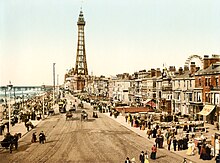
The extension of this form of leisure to the middle and working classes began with the development of the railways in the 1840s, which offered cheap fares to fast-growing resort towns. In particular, the completion of a branch line to the small seaside town of Blackpool from Poulton led to a sustained economic and demographic boom. A sudden influx of visitors, arriving by rail, led entrepreneurs to build accommodation and create new attractions, leading to more visitors and a rapid cycle of growth throughout the 1850s and 1860s.[10]
The growth was intensified by the practice among the Lancashire cotton mill owners of closing the factories for a week every year to service and repair machinery. These became known as wakes weeks. Each town's mills would close for a different week, allowing Blackpool to manage a steady and reliable stream of visitors over a prolonged period in the summer. A prominent feature of the resort was the promenade and the pleasure piers, where an eclectic variety of performances vied for the people's attention. In 1863, the North Pier in Blackpool was completed, rapidly becoming a centre of attraction for upper class visitors. Central Pier was completed in 1868, with a theatre and a large open-air dance floor.[11]
Many of the popular beach resorts were equipped with bathing machines, because even the all-covering beachwear of the period was considered immodest. By the end of the century the English coastline had over 100 large resort towns, some with populations exceeding 50,000.[12]
Expansion around the world

The development of the seaside resort abroad was stimulated by the well-developed English love of the beach. The French Riviera alongside the Mediterranean had already become a popular destination for the British upper class by the end of the 18th century. In 1864, the first railway to Nice was completed, making the Riviera accessible to visitors from all over Europe. By 1874, residents of foreign enclaves in Nice, most of whom were British, numbered 25,000. The coastline became renowned for attracting the royalty of Europe, including Queen Victoria and King Edward VII.[13]
Continental European attitudes towards gambling and nakedness tended to be more lax than in Britain, so British and French entrepreneurs were quick to exploit the possibilities. In 1863, Charles III, Prince of Monaco, and François Blanc, a French businessman, arranged for steamships and carriages to take visitors from Nice to Monaco, where large luxury hotels, gardens and casinos were built. The place was renamed[citation needed] Monte Carlo.
Commercial sea bathing spread to the United States and parts of the British Empire by the end of the 19th century. The first public beach in the United States was Revere Beach, which opened in 1896. During that same time, Henry Flagler developed the Florida East Coast Railway, which linked the coastal sea resorts developing at St. Augustine, FL and Miami Beach, FL, to winter travelers from the northern United States and Canada on the East Coast Railway. By the early 20th century surfing was developed in Hawaii and Australia; it spread to southern California by the early 1960s. By the 1970s cheap and affordable air travel led to the growth of a truly global tourism market which benefited areas such as the Mediterranean, Australia, South Africa, and the coastal Sun Belt regions of the United States.
Today

Joaquín Sorolla (1904)
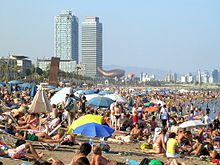


Beaches can be popular on warm sunny days. In the Victorian era, many popular beach resorts were equipped with bathing machines because even the all-covering beachwear of the period was considered immodest.[16]This social standard still prevails in many Muslim countries. At the other end of the spectrum are topfree beaches and nude beaches where clothing is optional or not allowed. In most countries social norms are significantly different on a beach in hot weather, compared to adjacent areas where similar behavior might not be tolerated and might even be prosecuted[clarification needed].
In more than thirty countries in Europe, South Africa, New Zealand, Canada, Costa Rica, South America and the Caribbean, the best recreational beaches are awarded Blue Flag status, based on such criteria as water quality and safety provision. Subsequent loss of this status can have a severe effect on tourism revenues.
Beaches are often dumping grounds for waste and litter, necessitating the use of beach cleaners and other cleanup projects. More significantly, many beaches are a discharge zone for untreated sewage in most underdeveloped countries; even in developed countries beach closure is an occasional circumstance due to sanitary sewer overflow. In these cases of marine discharge, waterborne disease from fecal pathogens and contamination of certain marine species are a frequent outcome.
Artificial beaches
Some beaches are artificial; they are either permanent or temporary (For examples, see Copenhagen, Hong Kong, Manila, Monaco, Nottingham, Paris, Rotterdam, Singapore, Tianjin, and Toronto).
The soothing qualities of a beach and the pleasant environment offered to the beachgoer are replicated in artificial beaches, such as "beach style" pools with zero-depth entry and wave pools that recreate the natural waves pounding upon a beach. In a zero-depth entry pool, the bottom surface slopes gradually from above water down to depth. Another approach involves so-called urban beaches, a form of public park becoming common in large cities. Urban beaches attempt to mimic natural beaches with fountains that imitate surf and mask city noises, and in some cases can be used as a play park.
Beach nourishment involves pumping sand onto beaches to improve their health. Beach nourishment is common for major beach cities around the world; however the beaches that have been nourished can still appear quite natural and often many visitors are unaware of the works undertaken to support the health of the beach. Such beaches are often not recognized by consumers as artificial. A famous example of beach nourishment came with the replenishment of Waikīkī Beach in Honolulu, Hawaii, where sand from Manhattan Beach, California was transported via ship and barge throughout most of the 20th century in order to combat Waikiki's erosion problems. The Surfrider Foundation has debated the merits of artificial reefs with members torn between their desire to support natural coastal environments and opportunities to enhance the quality of surfing waves. Similar debates surround beach nourishment and snow cannon in sensitive environments.
Restrictions on access
Public access to beaches is restricted in some parts of the world.[17][18] For example, most beaches on the Jersey Shore are restricted to people who can purchase beach tags.[19] Many beaches in Indonesia, both private and public, require admission fees.[20] Some beaches also restrict dogs for some periods of the year.[21]
Private beaches
Private beaches may belong to owners of abutting land, or neighborhood associations. Signs are usually posted the entrance. A permit or special use occasion event may be granted upon executing the proper channels to legally obtain one.
In some places, such as Florida, it is not always clear which parts of a beach are public or private.[22]
Public beaches
The first public beach in the United States opened on 12 July 1896, in the town of Revere, Massachusetts, with over 45,000 people attending on the opening day. The beach was run bay the Metropolitan Parks Commission and the new beach had a bandstand, public bathhouses, shade pavilions, and lined by a broad boulevard that ran along the beach.[23]
Public access to beaches is protected by law in the U.S. state of Oregon, thanks to a 1967 state law, the Oregon Beach Bill, which guaranteed public access from the Columbia River to the California state line, "so that the public may have the free and uninterrupted use".[24] Public access to beaches in Hawaii (other than those owned by the U.S. federal government) is also protected by state law. [25]
Access design

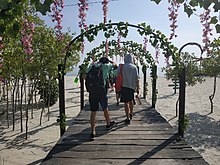
Beach access is an important consideration where substantial numbers of pedestrians or vehicles require access to the beach. Allowing random access across delicate foredunes is seldom considered good practice as it is likely to lead to destruction of flora and consequent erosion of the fore dunes.
A well-designed beach access should:
- provide a durable surface able to withstand the traffic flow;
- aesthetically complement the surrounding structures and natural landforms;
- be located in an area that is convenient for users and consistent with safe traffic flows;
- be scaled to match the traffic flow (i.e. wide and strong enough to safely carry the size and quantity of pedestrians and vehicles intended to use it);
- be maintained appropriately; and
- be signed and lit to discourage beach users from creating their own alternative crossings that may be more destructive to the beachhead.
Concrete ramp or steps
A concrete ramp should follow the natural profile of the beach to prevent it from changing the normal flow of waves, longshore currents, water and wind. A ramp that is below the beach profile will tend to become buried and cease to provide a good surface for vehicular traffic. A ramp or stair that protrudes above the beach profile will tend to disrupt longshore currents creating deposits in front of the ramp, and scouring behind. Concrete ramps are the most expensive vehicular beach accesses to construct requiring use of a quick-drying concrete or a cofferdam to protect them from tidal water during the concrete curing process. Concrete is favored where traffic flows are heavy and access is required by vehicles that are not adapted to soft sand (e.g. road registered passenger vehicles and boat trailers). Concrete stairs are commonly favored on beaches adjacent to population centers where beach users may arrive on the beach in street shoes, or where the foreshore roadway is substantially higher than the beach head and a ramp would be too steep for safe use by pedestrians. A composite stair ramp may incorporate a central or side stair with one or more ramps allowing pedestrians to lead buggies or small boat dollies onto the beach without the aid of a powered vehicle or winch. Concrete ramps and steps should be maintained to prevent a buildup of moss or algae that may make their wet surfaces slippery and dangerous to pedestrians and vehicles.
Corduroy (beach ladder)
A corduroy road or beach ladder (or board and chain) is an array of planks (usually hardwood or treated timber) laid close together and perpendicular to the direction of traffic flow, and secured at each end by a chain or cable to form a pathway or ramp over the sand dune. Corduroys are cheap and easy to construct and quick to deploy or relocate. They are commonly used for pedestrian access paths and light duty vehicular access ways. They naturally conform to the shape of the underlying beach or dune profile, and adjust well to moderate erosion, especially longshore drift. However, they can cease to be an effective access surface if they become buried or undermined by erosion by surface runoff coming from the beach head. If the corduroy is not wide enough for vehicles using it, the sediment on either side may be displaced creating a spoon drain that accelerates surface runoff and can quickly lead to serious erosion. Significant erosion of the sediment beside and under the corduroy can render it completely ineffective and make it dangerous to pedestrian users who may fall between the planks.
Fabric ramp
Fabric ramps are commonly employed by the military for temporary purposes where the underlying sediment is stable and hard enough to support the weight of the traffic. A sheet of porous fabric is laid over the sand to stabilize the surface and prevent vehicles from bogging. Fabric Ramps usually cease to be useful after one tidal cycle as they are easily washed away, or buried in sediment.
Foliage ramp
A foliage ramp is formed by planting resilient species of hardy plants such as grasses over a well-formed sediment ramp. The plants may be supported while they become established by placement of layers of mesh, netting, or coarse organic material such as vines or branches. This type of ramp is ideally suited for intermittent use by vehicles with a low wheel loading such as dune buggies or agricultural vehicles with large tyres. A foliage ramp should require minimal maintenance if initially formed to follow the beach profile, and not overused.
Gravel ramp
A gravel ramp is formed by excavating the underlying loose sediment and filling the excavation with layers of gravel of graduated sizes as defined by John Loudon McAdam. The gravel is compacted to form a solid surface according to the needs of the traffic. Gravel ramps are less expensive to construct than concrete ramps and are able to carry heavy road traffic provided the excavation is deep enough to reach solid subsoil. Gravel ramps are subject to erosion by water. If the edges are retained with boards or walls and the profile matches the surrounding beach profile, a gravel ramp may become more stable as finer sediments are deposited by percolating water.
Longest beaches
Amongst the world's longest beaches are:
- Eighty Mile Beach (220 kilometres [140 mi]) in north-west Australia;
- Praia do Cassino (212 kilometres [132 mi]) in Brazil;
- Padre Island beach (about 182 kilometres [113 mi]) in Gulf of Mexico, Texas.
- Ninety Mile Beach, Victoria (151 kilometres [94 mi]) in Victoria, Australia;
- Cox's Bazar, Bangladesh (150 kilometres [93 mi] unbroken);
- Naikoon Provincial Park (100 kilometres [62 mi]) in the north-east of Haida Gwaii, Canada;
- Playa Novillera beach (about 90 kilometres [56 mi]) in Mexico.
- 90 Mile Beach in New Zealand (88 kilometres [55 mi]);
- Fraser Island beach (about 65 kilometres [40 mi]) in Queensland, Australia;
- Troia-Sines Beach (63 kilometres [39 mi]) in Portugal;
- the Jersey Shore, 204 km/127 miles; and
- Long Beach, Washington (which is about 40 kilometres [25 mi]).
Wildlife

A beach is an unstable environment that exposes plants and animals to changeable and potentially harsh conditions. Some animals burrow into the sand and feed on material deposited by the waves. Crabs, insects and shorebirds feed on these beach dwellers. The endangered piping plover and some tern species rely on beaches for nesting. Sea turtles also bury their eggs in ocean beaches. Seagrasses and other beach plants grow on undisturbed areas of the beach and dunes.
Ocean beaches are habitats with organisms adapted to salt spray, tidal overwash, and shifting sands. Some of these organisms are found only on beaches. Examples of these beach organisms in the southeast US include plants like sea oats, sea rocket, beach elder, beach morning glory (Ipomoea pes-caprae), and beach peanut, and animals such as mole crabs (Hippoidea), coquina clams (Donax), ghost crabs, and white beach tiger beetles.[3]





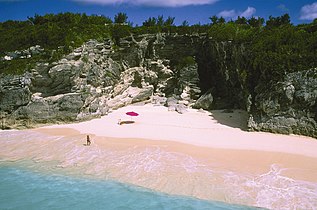



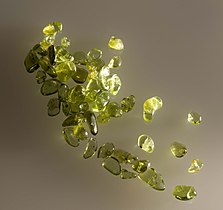










No comments:
Post a Comment